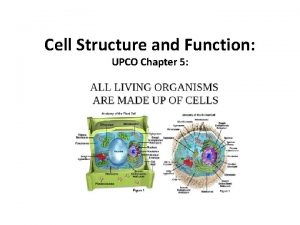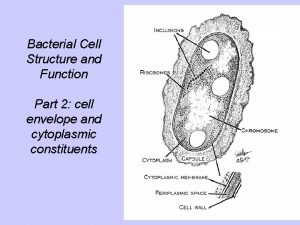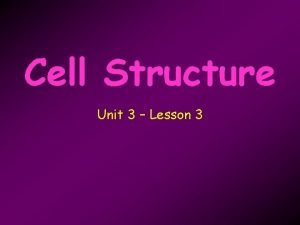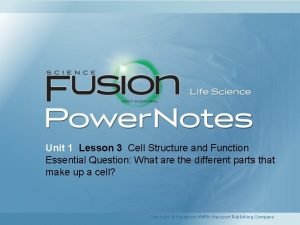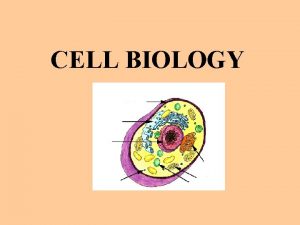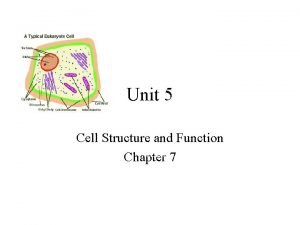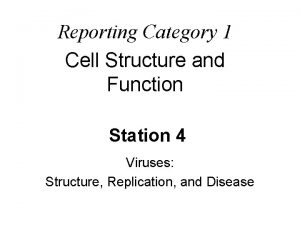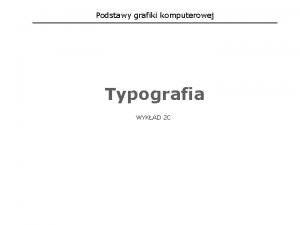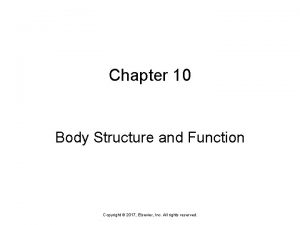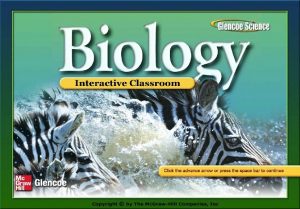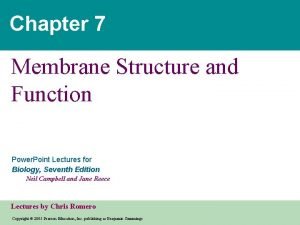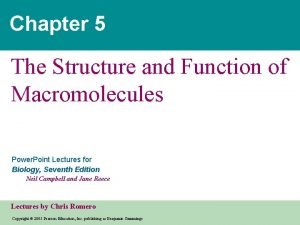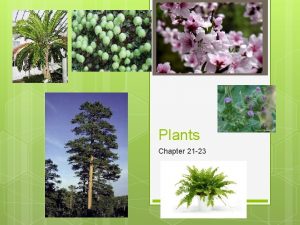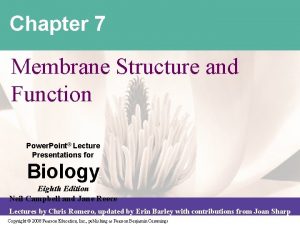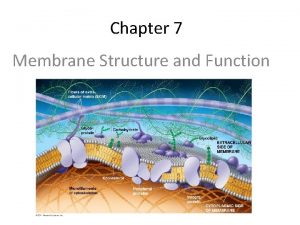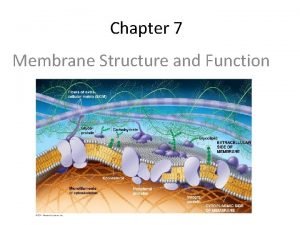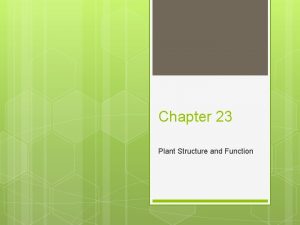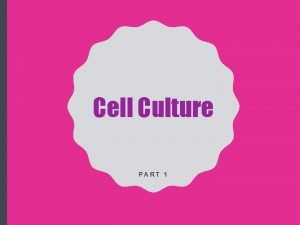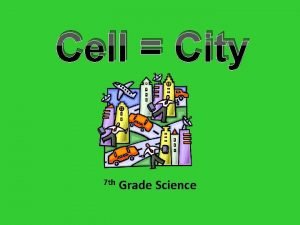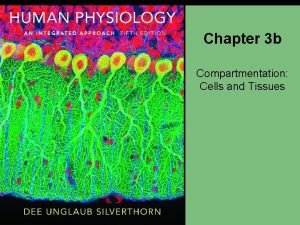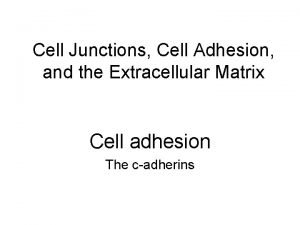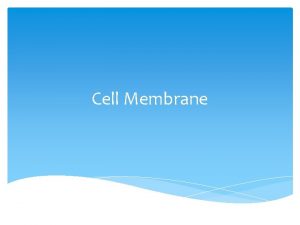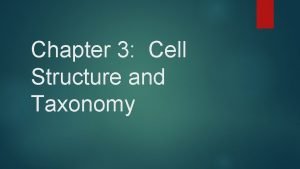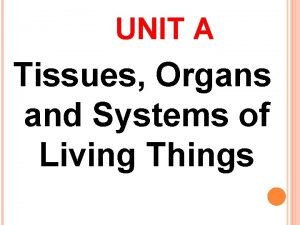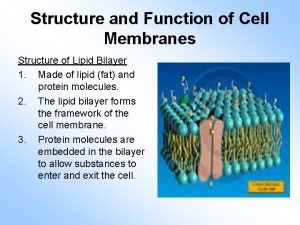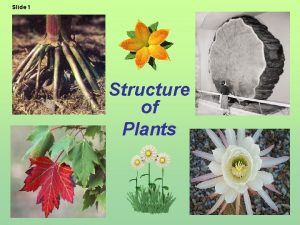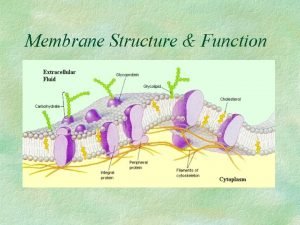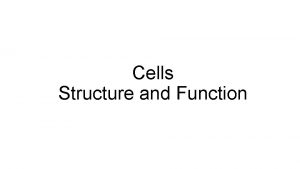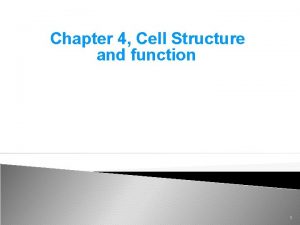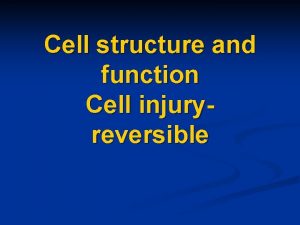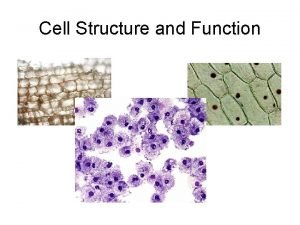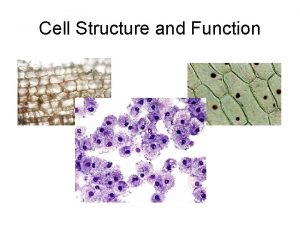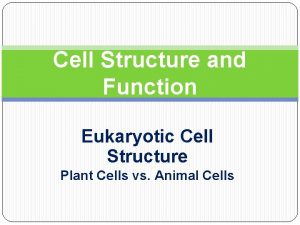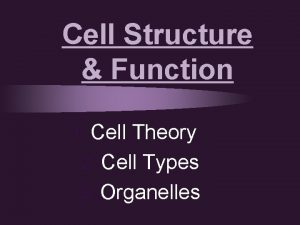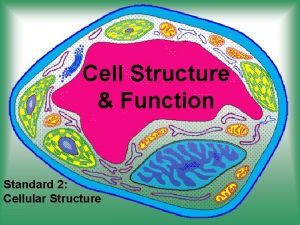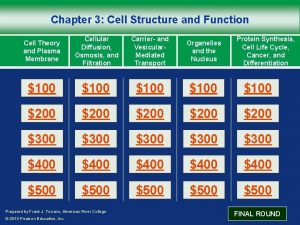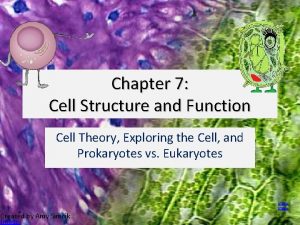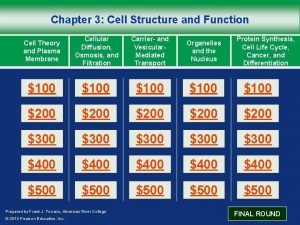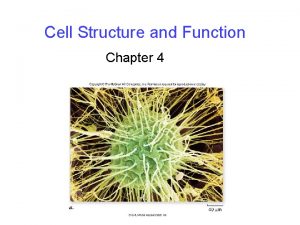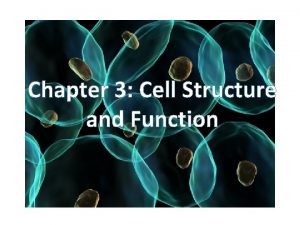Chapter 4 Cell Structure and Function SPIs 1





































































- Slides: 69

Chapter 4 Cell Structure and Function SPIs: • 1. 1 Identify the cellular organelles associated with major cell processes • 1. 2 Distinguish between prokaryotic and eukaryotic cells. • 1. 6 Determine the relationship between cell growth and reproduction. Conceptual Strand: • All living things are made of cells that perform functions necessary for life.

Chapter 4 Cell Structure and Function Table of Contents Section 1 The History of Cell Biology Section 2 Introduction to Cells Section 3 Cell Organelles and Features Section 4 Unique Features of Plant Cells

Chapter 4 Section 1 The History of Cell Biology I can… • Name the scientists who first observed living and nonliving cells. • Summarize the research that led to the development of the cell theory. • State three principles of the cell theory. • Explain why the cell is considered to be the basic unit of life.

Chapter 4 Section 1 The History of Cell Biology The Discovery of Cells • All living things are made up of one or more cells. • A cell is the smallest unit that can carry on all of the processes of life.

Chapter 4 Section 1 The History of Cell Biology The Discovery of Cells, continued • Hooke – discovered cells in slices of cork. • Leeuwenhoek – first to observe living cells in microorganisms.

The Cell Theory • Schleiden: all plants composed of cells • Schwann: All animals composed of cells • Virchow: all cells come from other cells

Chapter 4 Section 1 The History of Cell Biology The Cell Theory • States all living organisms are made of one or more cells, cells are the basic units of structure and function, and cells come only from pre-existing cells.

Chapter 4 Section 1 The History of Cell Biology Cell Theory Click below to watch the Visual Concept

Chapter 4 Section 1 The History of Cell Biology The Cell Theory, continued • Cellular Basis of Life – All living things are made of organized parts, obtain energy from their surroundings, perform chemical reactions, change with time, respond to their environment, and reproduce.

Bellringer # 1 State three principles of the cell theory. • Turn in syllabus and lab fee. Get out notes from yesterday.

4. 1 Vocab 1. Cell 2. Cell theory 3. Robert Hooke 4. Anton van Leeuwenhoek 5. Matthias Schleiden 6. Theodor Schwann 7. Rudolf Virchow 8. Homeostasis 9. Protists 10. Microscope

Bellringer #2 Hooke’s discovery of cells was made observing a. Living algal cells. b. Living human blood cells. c. Dead plant cells. d. Dead protist cells. Set up notes for 4. 2. Open text to pg 72. Bring Lab fees.

Chapter 4 Section 2 Introduction to Cells I CAN… • Explain the relationship between cell shape and cell function. • Identify the factor that limits cell size. • Describe three basic parts of a cell. • Compare prokaryotic cells and eukaryotic cells. • Analyze the relationship among cells, tissues, organ systems, and organisms.

Chapter 4 Section 2 Introduction to Cells Cell Diversity • Cell Shape – A cell’s shape reflects its function.

Chapter 4 Section 2 Introduction to Cells Cell Diversity, Continued • Cell Size –limited by a cell’s surface area –to-volume ratio. If a cell were too large, the surface area would not allow materials to enter or exit quickly enough.

Chapter 4 Section 2 Introduction to Cells Basic Parts of a Cell • 3 basic parts of cell:

Chapter 4 Section 2 Introduction to Cells Internal Organization of a Cell Click below to watch the Visual Concept

Chapter 4 Section 2 Introduction to Cells Basic Parts of a Cell, continued 1. plasma membrane (cell membrane) • covers cell’s surface • acts as barrier between inside and outside of cell. • composed of double layer of phospholipids (hydrophobic tails)

Chapter 4 Section 2 Introduction to Cells Basic Parts of a Cell, continued 2. Cytoplasm • within the plasma membrane • includes the fluid (cytosol), the cytoskeleton, and all organelles except nucleus

Chapter 4 Section 2 Introduction to Cells Basic Parts of a Cell, continued 3. Control Center –contains cell’s DNA.

Chapter 4 Section 2 Introduction to Cells Two Basic Types of Cells • Prokaryotes – lack nucleus and membranebound organelles. – Divided into 2 domains: Bacteria and Archaea

Chapter 4 Section 2 Introduction to Cells Two Basic Types of Cells, continued 2. Eukaryotes –have a nucleus and membrane-bound organelles. –PRO=NO, EU=DO

Chapter 4 Section 2 Introduction to Cells Comparing Prokaryotes and Eukaryotes Click below to watch the Visual Concept

Chapter 4 Section 2 Introduction to Cells Cellular Organization • In multicellular eukaryotes, cells organize into tissues, organ systems, and finally organisms.

4. 2 Vocab 1. Plasma membrane 2. Cytoplasm 3. Nucleus 4. Prokaryote 5. Eukaryote 6. Organelle 7. Tissue 8. Organ 9. Organ system 10. Phospholipid bilayer

Bellringer #3 Which of the following is an example of a prokaryotic cell? a. An amoeba b. A virus c. A bacterium d. A liver cell Get out colored pencils.

Bellringer #4 The size to which a cell can grow is limited by it’s a. Location b. Structure c. Function d. Surface area Open text to pg. 77. Get out your animal cell foldable.

Chapter 4 Section 3 Cell Organelles and Features I CAN… • Describe the structure and function of a cell’s plasma membrane. • Summarize the role of the nucleus. • List the major organelles found in the cytosol, and describe their roles. • Identify the characteristics of mitochondria. • Describe the structure and function of the cytoskeleton.

Chapter 4 Section 2 Introduction to Cells Basic Parts of a Cell, continued 5. plasma/cell membrane • SEMI-PERMEABLE barrier between inside and outside of cell. • phospholipid bilayer (hydrophobic tails) • has embedded proteins with specific jobs

Chapter 4 Structure of Lipid Bilayer Section 3 Cell Organelles and Features

Chapter 4 Section 2 Introduction to Cells 6. Cytoplasm • includes cytosol (liquid and dissolved contents), cytoskeleton, and all organelles except nucleus. • Where metabolism and specialized functions of the cell are carried out.

Chapter 4 Section 3 Cell Organelles and Features 15. Nucleus • directs cell’s activities (control center) • stores and protects DNA. • Contains Nucleoplasm: liquid that holds contents of nucleus. • Where RNA is made.

13. DNA • Hereditary information that contains instructions for structure and function of organism • DNA in thread form: chromatin. • Chromatin condenses to form chromosomes when the cell is about to divide.

Chapter 4 Section 3 Cell Organelles and Features Nucleus of a Cell

Chapter 4 Section 3 Cell Organelles and Features 12. Nuclear Membrane/ Envelope –double membrane that surrounds and protects nuclear contents. –contains nuclear pores

11. Nuclear pores • Channels in nuclear membrane that allow certain substances to be transported between nucleoplasm and cytoplasm.

Chapter 4 Section 3 Cell Organelles and Features Nucleus, continued 14. Nucleolus –Center for ribosome synthesis and assembly.

Bellringer #5 The structure that regulates what enters and leaves the cell is called the a. Nucleus b. Cell wall c. Nuclear membrane d. Plasma membrane • Get out animal cell foldable. Open text to pg 80.

Chapter 4 Section 3 Cell Organelles and Features 7. Mitochondria • harvest ENERGY from organic compounds and transfer it to ATP through aerobic respiration

Chapter 4 Section 3 Cell Organelles and Features 17. Ribosomes • either free or attached to rough ER • play role in protein synthesis through a process called translation. • Do not have membrane • Composed of a large and small subunit.

Chapter 4 Section 3 Cell Organelles and Features Ribosomes Click below to watch the Visual Concept

Chapter 4 Section 3 Cell Organelles and Features Endoplasmic Reticulum 16. Rough Endoplasmic Reticulum • Covered with ribosomes • Form vesicles that contain their protein products • Vesicles are sent to Golgi for further processing.

Chapter 4 Section 3 Cell Organelles and Features Endoplasmic Reticulum, continued 8. smooth ER • Lacks ribosomes • builds and stores lipids and steroids. • participates in detoxification of toxins.

Chapter 4 Section 3 Cell Organelles and Features Endoplasmic Reticulum (ER) and Ribosomes Click below to watch the Visual Concept

Chapter 4 Section 3 Cell Organelles and Features 18. Golgi Apparatus/body • processes and packages proteins. • Ship packages (vesicles) throughout and outside the cell.

Chapter 4 Section 3 Cell Organelles and Features 19. Vesicles • Packages that are classified by contents. • Often merge with plasma membrane to release contents to outside of cell.

4. lysosome • Vesicle formed by the Golgi that contain digestive enzymes used to: – Break down and recycle worn out organelles – Engulf and destroy viruses and bacteria – Break down the cell itself (autolysis)

1. Peroxisome • Contain enzymes responsible for metabolic reactions. • Detoxify alcohol and other drugs.

Bellringer # 6 In which of the following organelles is a cell’s ATP produced? a. Mitochondrion b. Endoplasmic Reticulum c. Golgi Apparatus d. Lysosome Get out blank sheet of paper. Put name on it, title it: “Cell Video Facts”

Bellringer # 7 An organelle that helps maintain homeostasis by moving supplies from one part of the cell to the other is the a. Endoplasmic reticulum b. Mitochondrion c. Nucleus d. Cytoplasm Get out animal cell foldable. Open text to pg 84. Get a new vocab sheet.

Chapter 4 Section 3 Cell Organelles and Features 10. Cytoskeleton • help cells move and maintain shape. • Provides structural support for cytoplasm • Made of: microtubules, microfilaments, and intermediate filaments.

Chapter 4 Section 3 Cell Organelles and Features Cytoskeleton Click below to watch the Visual Concept

Chapter 4 Section 3 Cell Organelles and Features Cytoskeleton, continued 2. Cilia – Short, hair-like projections that extend from the surface of the cell – Assist in movement 9. Flagella – Long, whip-like structure used to propel cell

Chapter 4 Section 3 Cell Organelles and Features Structure of Cilia and Flagella Click below to watch the Visual Concept

Chapter 4 Section 3 Cell Organelles and Features Cytoskeleton, continued 3. Centrioles –Found in pairs in animal cell –involved in cell division.

4. 3 Vocab 1. Nucleolus 2. Ribosome 3. Mitochondrion 4. Endoplasmic reticulum 5. Golgi apparatus 6. Lysosome 7. Cytoskeleton 8. Cilium 9. Flagellum 10. Centriole

Bellringer # 8 Numerous hair like organelles that protrude from the surface of a cell and are packaged in tight rows are called a. Flagella b. Microtubules c. Actin filaments d. Cilia Get plant cell foldable and colored pencils. Open text to pg 87.

Chapter 4 Section 4 Unique Features of Plant Cells I Can… • List three structures that are present in plant cells but not in animal cells. • Compare the plasma membrane, the primary cell wall, and the secondary cell wall. • Explain the role of the central vacuole. • Describe the roles of plastids in the life of a plant. • Identify features that distinguish prokaryotes, eukaryotes, plant cells, and animal cells.

Chapter 4 Section 4 Unique Features of Plant Cells 20. Cell Wall • • covers cell membrane provides support and protection. Contains cellulose Has pores for molecules to enter and exit the cell

Chapter 4 Section 4 Unique Features of Plant Cells Parts of a Cell Wall Click below to watch the Visual Concept

Chapter 4 Section 4 Unique Features of Plant Cells 7. Central Vacuole • Large • stores water, enzymes, and waste products • provides support for plant tissue. • In dry periods, vacuole loses water and cell shrink, causing plant to wilt.

Chapter 4 Section 4 Unique Features of Plant Cells 9. Chloroplast • converts light energy into chemical energy by photosynthesis. • Contain stacks of thylakoids where the light reactions take place • Stroma: fluid where Calvin Cycle occurs

2. Amyloplast • Store starch

Bellringer # 9 Plant cells have a large membrane-bound space called _____ in which water, waste products, and nutrients are stored. a. Mitochondrion b. Chloroplast c. Golgi Apparatus d. Central Vacuole Get out plant Cell foldable. Turn in “Selecting a science Project topic” into basket.

Chapter 4 Section 4 Unique Features of Plant Cells Remaining Plant Cell Answers 1. Plasmodesma 12. Nuclear membrane/envelope 3. Peroxisome 13. DNA in nucleoplasm 14. Nucleolus 4. Golgi Body 15. Nucleus 5. Golgi Vesicles 16. RER 17. SER 6. Tonoplast 18. Ribosomes 8. Mitochondrion 19. Cytoplasm 10. Cytoskeleton 21. Cell/plasma membrane 11. Nuclear Pore

Chapter 4 Section 4 Unique Features of Plant Cells Comparing Plant and Animal Cells

Bellringer # 10 Which of the following pairs contain unrelated items? a. eukaryote-amoeba b. Ribosomes-proteins c. Cell wall-animal cell d. mitochondria-energy Get out 4. 3 Vocab. Turn Cheek/Onion Cell to basket.

4. 4 Vocab 1. Cell wall 2. Central vacuole 3. Chloroplast 4. Thylakoid 5. Chlorophyll 6. Vesicle 7. Amyloplast 8. Cellulose 9. Stroma 10. Photosynthesis

Bellringer # 11 When the lysosome breaks down the cell, it is called a. Photosynthesis b. Autolysis c. Endocytosis d. Exocytosis Get all parts of chapter 4 notebook out. Turn Microscope drawings in
 Eukaryotic cell structure
Eukaryotic cell structure Chapter 7 cell structure and function section review 7-2
Chapter 7 cell structure and function section review 7-2 Chapter 5 cell structure and function
Chapter 5 cell structure and function Function of the cell wall
Function of the cell wall Chapter 4 cell theory and cell study
Chapter 4 cell theory and cell study Bacterial cell structure and function
Bacterial cell structure and function Lesson 3 cell structure and function answer key
Lesson 3 cell structure and function answer key Cell graphic organizer
Cell graphic organizer Plant cell vs animal cell
Plant cell vs animal cell What cell is this
What cell is this Cell organelle graphic organizer
Cell organelle graphic organizer Cell structure and function
Cell structure and function Unit 5 cell structure and function answer key
Unit 5 cell structure and function answer key Category 1 cell structure and function
Category 1 cell structure and function Category 1 cell structure and function
Category 1 cell structure and function Category 1 cell structure and function
Category 1 cell structure and function Razlagalni spis
Razlagalni spis Kako napisati spis
Kako napisati spis Czcionka majuskuła
Czcionka majuskuła Uporządkowany spis książek
Uporządkowany spis książek E-spis lite
E-spis lite Spis form
Spis form Spis polyu
Spis polyu Difference between mercury cell and diaphragm cell
Difference between mercury cell and diaphragm cell Prokaryotic cell and eukaryotic cell similarities
Prokaryotic cell and eukaryotic cell similarities Plant vs animal cells organelles
Plant vs animal cells organelles Vacuole function
Vacuole function Primary battery and secondary battery
Primary battery and secondary battery Difference between plant and animal cell
Difference between plant and animal cell Cell cycle and cell division
Cell cycle and cell division Prokaryotic cell and eukaryotic cell
Prokaryotic cell and eukaryotic cell Idealized animal cell
Idealized animal cell Walker cell and hadley cell
Walker cell and hadley cell Cell cycle and cell division
Cell cycle and cell division Plant and animal cells venn diagram
Plant and animal cells venn diagram Cell cycle phases in order
Cell cycle phases in order Galvanic cell and electrolytic cell
Galvanic cell and electrolytic cell Animal cell and plant cell
Animal cell and plant cell Chapter 10 body structure and function
Chapter 10 body structure and function Chapter 22 plant structure and function answer key
Chapter 22 plant structure and function answer key Chapter 7 membrane structure and function
Chapter 7 membrane structure and function Chapter 5 the structure and function of macromolecules
Chapter 5 the structure and function of macromolecules Chapter 21 plant structure and function
Chapter 21 plant structure and function Chapter 7 membrane structure and function
Chapter 7 membrane structure and function Flaccid cell
Flaccid cell Chapter 7 membrane structure and function
Chapter 7 membrane structure and function Section 23-4 leaves
Section 23-4 leaves Cell city analogy project
Cell city analogy project Prokaryotic vs eukaryotic cell
Prokaryotic vs eukaryotic cell Balancing redox reactions in acidic solution
Balancing redox reactions in acidic solution Dry cell vs wet cell
Dry cell vs wet cell Carbohydrate in cell membrane
Carbohydrate in cell membrane Morphology of cells in culture
Morphology of cells in culture Finite and continuous cell lines
Finite and continuous cell lines Cell city project animal cell
Cell city project animal cell Cell-cell junction
Cell-cell junction Cell-cell junction
Cell-cell junction What cell organelle is like lysol spray cleaning the cell
What cell organelle is like lysol spray cleaning the cell Carbohydrate side chain
Carbohydrate side chain Prokaryotic cell vs eukaryotic cell
Prokaryotic cell vs eukaryotic cell Biology.arizona.edu/cell bio/activities/cell cycle/01.html
Biology.arizona.edu/cell bio/activities/cell cycle/01.html Matlab variable in string
Matlab variable in string Cell membrane location and function
Cell membrane location and function Cell structure and taxonomy
Cell structure and taxonomy School community definition
School community definition Phloem
Phloem A tissues
A tissues Lipids cell membrane function
Lipids cell membrane function 3 functions of leaves
3 functions of leaves Function of the cell wall
Function of the cell wall


